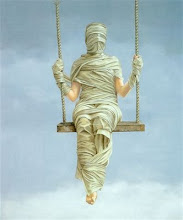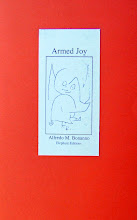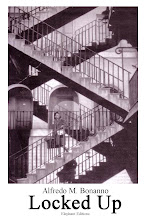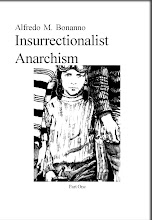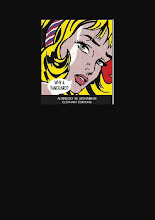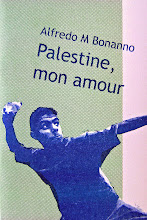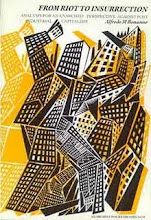The book we are presenting here is an interesting attempt by Osvaldo Bayer to reconstruct the activities of the Italian anarchist Severino Di Giovanni in Argentina in the 1920's. It also bears all the consequences of such a difficult task undertaken with the thorough but limited tools of the journalist.
The figure of Di Giovanni has always highlighted a profound division within the anarchist movement, which goes far beyond the boundaries of the specific events in his lifetime. From well before the period of his activity, right up to the present day, there have always been comrades who include the methods of direct action, armed struggle and expropriation in the struggle against exploitation. On the other hand there have always been those who are against these methods, in favour of propaganda and libertarian educationism alone. The latter is the position that was held by the anarchists involved in the anarchist daily La Protesta in Di Giovanni's time. Today there are still many who hold this position and who would no doubt have preferred us to have left Di Giovanni and what he represents in relative obscurity.
As it stands, this book contains certain defects which need to be pointed out and which we shall examine further on. Bayer's work, however, is an honest and objective attempt far removed from the stereotypes so dear to the bourgeois press. Contemporary accounts of his activities filled columns and columns about Di Giovanni, painting him as a bomb-thrower, bandit and assassin.
Not only the yellow press, but also areas from which one would expect better have insisted on seeing Di Giovanni both detached from the brutal and homicidal reality in which he lived and carried on his struggle, and detached from the anarchist movement of which he was a part.
For example the author to the preface of the Spanish edition of this book, Jose Luis Moreno, states, "Di Giovanni wanted from violence what the bourgeoisie wanted from law: an instrument to obtain a final aim which, naturally in both cases, were different and antagonistic. Di Giovanni believed he could fight the bourgeoisie with their own weapons". And further on, "...he used his arsenal of war like a basic instrument, relegating ideological problems to second place. For him, as for many anarchists, that is what `direct action' meant". And again, "In reality he was a romantic. Paradoxical as it might seem, and quoting Bayer, we would say he was a romantic of violence. Love and Violence are real ends: and for him there were no others".
It might be difficult at first glance to draw a distinction between the proletarian violence of defence and the oppressive and terroristic violence of the State. But this distinction can and must be made. In attacking institutions arms in hand, Di Giovanni was not using the same weapons as the bourgeoisie, but the quite different ones of liberation and popular vindication. And wherever did the author of the preface read that Di Giovanni put ideological problems in second place? Perhaps he could have done better in Di Giovanni's place, hunted and followed by the police like a wild animal, but still bringing out numerous anarchist publications, including a fortnightly paper Culmine, and an edition of Reclus' work? And finally, why define him a romantic? When we well know that today bourgeois historiography links this term to the decadent aspects of romantic poetics, those out of touch with or turning away from reality? To use this term today can only confuse the reader. There existed for Di Giovanni far more than Love and Violence: the struggle against fascism, the trade union struggle, the struggle for a new society—the struggle for anarchy. All were undertaken in full awareness of the need to use dangerous means, means which were justified only by the open war declared by those in power.
To return to the book. As We have said, it is an objective reconstruction far from the sensationalism of Di Giovanni's time. The development of Di Giovanni's activity has been followed attentively, through consulting contemporary newspapers, documents and testimonies. From the events at the Colon Theatre to the final moment in the face of the firing squad, we encounter Di Giovanni through a mixture of distance and sympathy. Not having had access to the sources used, we can only accept the conclusions reached by the historian, and consider his work to be positive. It is other aspects of the book that give us cause for concern, particularly the frequent recourse to value judgements all linked to a "romantic and idealist" vision of Di Giovanni's revolutionary activity.
It is not our intention to deprive the reader of the pleasure of reading the rich narrative which Bayer supplies, so we will not attempt to go over Di Giovanni's activity here. We do however feel it is necessary to attempt to indicate the lack of foundation to Bayer's theoretical conclusions.
For example, he writes, "As a self-taught man, Di Giovanni believed in theory implicitly. And in his tragic naivete he believed that theory was made to be applied. If Bakunin or Kropotkin stated that, for the revolution and the achievement of freedom, all means are legitimate, Di Giovanni would use these means." (page 44)
It is in such passages that we realize that Bayer, although a conscientious researcher, has either not read, or has not understood anything of anarchist thought. Whereever did he find the statement that "Bakunin and Kropotkin say that all means are justifiable?" Where did he read that to use anarchist theory acritically is typical of the selftaught? Where did he learn that anarchist theory is theory made only to remain on paper? Di Giovanni was a coherent man. It is not true that any means were good in his opinion. He always chose means in relation to the terroristic violence of the structures of power, and he stayed on this road to the end. To ask oneself, as our author does, the psychology of his relationship to anarchist theory does not make sense. Face to Face with the Enemy, Galleani's famous volume, and also the title of a section of Di Giovanni's paper Culmine, clearly shows the true substance of the relationship between theory and praxis. Di Giovanni knew that the attack against oppression had to use certain means, but he also knew that the other means—anarchist propaganda and publications—were of great value because they serve to prepare the field for active revolutionary intervention. But for this exchange between theory and praxis to come about, the first had to be developed in a certain direction, not become an 'obstacle in the path of direct action as in the case of the La Protesta editors.
Another interesting interpretation of Di Giovanni that Bayer makes is to identify him with Nietzschean individualism. This is an interesting problem. Bayer mentions the German philosopher's presence in Di Giovanni's thinking more than once. In fact his influence cannot be denied. Bayer tells us, "Noticable in Di Giovanni was the pronounced influence of Nietzsche (in searching through his library in Burzaco, police were to discover printed posters displayed on the walls and bearing quotations from the author of Thus Spoke Zarathustra)." (page 123), and in a letter of October 22 1928, Di Giovanni himself writes, "Oh, how many are the problems that crop up along the pathway of my young life, beset by thousands of winds of evil. Even so, the angel in my head has told me so very many times that only in evil is there life. And I live my life to the full. The sense of my existence has been lost in that ...in that evil? Evil makes me love the purist of angels. Do I perhaps do evil? But is that my guide? In evil lies the highest affirmation of life. And by being evil, am I mistaken? Oh, problem from the unknown, why do you defy solution?" From this Bayer concludes, "That tenderness turned to ruthlessness later when action was called for. Apparently he was a wholly impulsive man who surrendered fully to his emotions and behaved as if intoxicated by the whole gamut of colours, struggles, contradictions, beauties, generosities and betrayals that life has to offer, which is to say that he is a true Nietzschean."(page 64)
Reading Nietzsche certainly makes an impact on many, and probably did so on Di Giovanni. But to go on from this to define the man and his actions as Nietzschean seems too great a step. Even the presence of some phrases from Nietzsche's works in our comrade's library seems too modest an element to justify the claim that he was a dedicated follower of the philosopher's doctrines. This is a very serious problem and one which affects all the actions of an anarchism that insists on direct action and, while not denying the importance and value of propaganda and education, accentuates the importance of the attack against oppression.
It is not true that Di Giovanni "acted as though intoxicated by the whole gamut of colours, struggles, contradictions...". The fullness of his conception of life had nothing of the improvised violence which confuses itself with the vital force in Nietzsche's philosophical dimension. We must not forget the German philosopher's vision of the essence of the world and of history, nor his admiration for the ideal of the "superman". In Nietzsche the deterministic element of the eternal return interacts with the voluntaristic and mystical element of the will to power. These opposing tendencies make the philosopher say interesting things about nationalism, religion and war; but also absurd and dangerous affirmations which in the mouths of the followers of national socialism, have wrongly made him a "rightwing" philosopher. The reading of Nietzsche, as of Stirner, is quite a difficult task and it has nearly always been done badly. But there exists a clear division between Di Giovanni's reading of Nietzsche and his revolutionary anarchist activity. The voluntaristic aspect of his activity never aimed at creating a myth or of tracing the model of the "superman". He always bore in mind a precise situation of struggle, one which emerged from class exploitation and fascist oppression. This situation was continually being verified on a theoretical level in his paper Culmine.
One should not be misled by the flowery and overflowing prose that was once quite common among libertarian writers of the time (Galleani is one example). When he says that "only in evil is there life", the literary reference relates directly to a contradiction that is quite evident in a man who has chosen the road of the "outsider". If the bourgeois dimension of life is what everyone defines "good", then only in "evil" is there true life, only in breaking the circle of hypocrisy and false love of good is it possible to find a different, more essential good, the only one capable of founding the society of tomorrow through the pain and suffering of today. Even in his relationship with the very young comrade Josefina is he aware that, from the bourgeois point of view, his action could be condemned and considered evil: but what if it is precisely this evil that makes him feel he is right and affirming life? Then there is nothing left to do than to put words aside, look reality in the face, and act.
And so we come to the third problem which emerges from reading this book: that of terrorism. Once again Bayer gives way to value judgements and loses himself in absurd, unfounded statements: "Di Giovanni was an illstarred hero, a young man who took seriously everything which the texts of his ideology told him. That ideology, as he interpreted it, can shift from goodness and respect for human life in every circumstance, to the most desperate and violent action explained away by an ideal that seeks to secure absolute liberty for all."(page 250). It is therefore indispensable that the reader bear in mind Bayer's absolute lack of understanding as to what anarchism is and what, in fact, Di Giovanni's actions mean.
But our problem is a little different. Along with his comrades, Di Giovanni carried out actions which are normally defined "terrorist". He himself wrote, "In the eternal struggle against the State and its props, the anarchist who is fully alive to his function and his rebelliousness which arise out of the ideal which he professes and out of his conception of action, cannot very often foresee that the avalanche which he will shortly bring tumbling down the hillside will trap his neighbour's tail ...this neighbour who is absorbed in contemplation of the heavens." (page 71)
First of all it needs to be said clearly what terrorism is. State propaganda by the usual servants in the pay of the bourgeois press has always described as terrorism actions by individuals or groups against those responsible for exploitation, against property, State institutions and constituted order. The other terrorism, the real terrorism carried out by the State directly using the army in war, or by the bosses at the workplace, has never been considered terrorism. The thousands of workers killed or maimed every year in this country alone. The poisoned sweets, hallucinogenic gases, defoliants and every kind of bacteriological arm perfected in Vietnam, now the patrimony of all the warmongering States. In Di Giovanni's time the favourite sport of the Argentinian bourgeoisie was "hunting" in the Tierra del Fuego, during which the natives of the forests were shot dead. The same people who shot those "savages" in cold blood for the pleasure of the hunt, were the most vigorous in condemning Di Giovanni's actions. Evidently when terrorism is practised against others it does not disturb the delicate palate of the bourgeoisie. But when the threat of it appears near to home, then their opinion changes.
It is right therefore that when we speak of repressive violence that we should speak of terrorism, but when speaking of the violence of the exploited in their own defence, the use of the term becomes the cause of misunderstanding and long, pointless discussions.
And Di Giovanni's actions were never violent for the sake of it. They were never indiscriminately applied to create a tension that would only favour power and its politics of consolidation. Di Giovanni's actions were always guided by a precise revolutionary reasoning: to strike the centres of power with punitive actions that find their justification in the State's violence, and which were aimed at pushing the mass towards a revolutionary objective. Di Giovanni always took account of the situation of the mass, even though he was often accused of not having done so. He was also accused of having contributed to the repression unleashed against the anarchist movement. In fact such an accusation is not possible. Police repression only kills a revolutionary movement if it is already dead in its most essential component, the attack against power. In other words, if a revolutionary movement in a social democratic situation deludes itself that it exists only because it vegetates in the shadow of governmental tolerance, it is logical that a wave of repression will always end up destroying it. But in fact this repression only kills a lifeless corpse, one that deluded itself that it was alive because, like a vegetable, it threw out a few seeds or generated a number of groups who spread nothing but opinions. It is necessary to interpret Di Giovanni's activity and its relationship with the Argentinian anarchist movement in this context.
Last, it is necessary to say something about the possible "accidents" which every revolutionary must try, as far as possible to avoid in the course of the attack against power. These "accidents" are always quite deplorable because they are seen in a negative light by the mass of the exploited, and because they endanger the lives of people who, taken individually, are not responsible for one particular act of repression. But when the violent act, decided by a militant or group of militants, is carried out with opportune analysis and guarantee; when its political opportunity has been considered and it is carried out with the maximum possibility of comprehension by the mass; and the militant or group are really part of the armed minority of the exploited: then if the action causes an "accident" and someone dies during the course of it, we cannot condemn the action and the comrades who carried it out.
In any case, even when we don't agree with a particular action and criticism seems justified, we must always bear in mind that our criticism cannot go beyond that particular action. To go on to draw general principles from it—however logical they might seem—is always gratuitous and dangerous from a revolutionary point of view.
Many serious arguments about Di Giovanni would not make sense if the comrades who took part in them, in the past as still today, had not started off with misconceptions about the function and aims of revolutionary action. Osvaldo Bayer's book can supply a key to understanding this problem within the limits of the events he relates and the documents he produces—but it must be used with care.
skip to main |
skip to sidebar
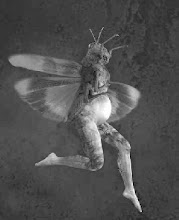
Some writings of Alfredo Maria Bonanno in English, or almost

Alfredo Bonanno was arrested on October 1st 2009 in Greece, accused of concourse in robbery. With him, anarchist comrade Christos Stratigopoulos.
Here are a few translations and part translations of a small portion of Alfredo's writing. This is a work in progress, many of the translations are as yet incomplete. Open links to find more of Alfredo's work.
Alfredo Bonnano Released
Nov. 22 Alfredo Bonnano was sentenced to 4 years imprisonment (which practically means that with the time served so far and the fact that he is over 70years old HE IS RELEASED
Christos Stratigopoulos (who took responsibility for the action)
was sentenced to 8 years and 9 months with the Greek law will probably be released at the end 2011
BY ANY MEANS NECESSARY
LINKS
click on any of these labels to read text
- "Community" sickness
- 1981 - Editorial
- A Critique of Syndicalist Methods
- A few notes on Sacco and Vanzetti
- A few notes on the revolutionary movement in Italy
- A little man in Singapore
- A million jobs
- A question of class
- Affinity
- After Marx autonomy
- Albania Laboratory of Subversion (Introduction)
- Anarchism and the national liberation struggle
- Anarchists and action
- AND WE WILL ALWAYS BE READY TO STORM THE HEAVENS AGAIN (Against amnesty)
- ANTI-INSTITUTIONAL MOVEMENT
- Are we modern?
- Armed Joy
- ARMED STRUGGLE. SOME REFLECTIONS.
- Autonomous base nuclei
- beyond syndicalism
- Beyond workerism
- But what is the imaginary?
- Class War
- Comiso - Organizational document of the self-managed leagues
- Considerations on illegality
- Dissonances (Introduction)
- Elephant Editions 1986
- Excluded and included
- Farewell to claiming
- Feral Revolution (Introduction)
- FICTITIOUS MOVEMENT AND REAL MOVEMENT
- For an Antiauthoritarian Insurrectionist International - Proposal for a debate
- From riot to insurrection
- From the centre to the periphery
- Good technology
- Guerilla Extraordinary
- Habits and idols
- Hegel
- I know who killed chief superintendent Luigi Calabresi
- Illegality
- Illness and capital
- Informal organisation
- Insurrection
- Internationalism
- Introduction to Sabate
- Introduction to Anarchism and Violence
- Introduction to Bratach Dubh English edition of Malatesta's Fra Contadini
- Introduction to Insurrectionalist Anarchism
- Introduction to Strange Victories
- Introduction to The Conquest of Bread
- Involuntary aspects of voluntary work
- Let's destroy work
- LET'S DESTROY WORK. New introduction
- Let's keep our feet on the ground please
- Lightening Conductors and Stand-ins - more shots of non-news
- Lightning Conductors and Stand-ins
- Lightning Conductors and Stand-ins (cont.)
- Locked up
- Looking forward to self-management
- Loss of language
- More on internationalism
- National Liberation Struggle
- nineteen years on
- No more crises
- Non-news about drugs
- Non-news about racism
- Ode to the Uniform
- On Feminism
- One's life on the line
- Order and chaos
- Otto Ruhle (Introductory Note)
- OUR ROLE IN THE PRESENT CONFLICT
- Palestine mon amour
- Pantagruel anarchist review
- Pinelli
- Prison and Prisoners’ Struggles - Introduction
- Propulsive Utopia
- Quality and the factory
- Restructuring Capital and the new democracy
- Revolution - Violence - Antiauthoritarianism
- REVOLUTIONARY VIOLENCE
- Science and the social revolution
- Self-management
- Severino Di Giovanni in Argentina 1923-1931 by Osvaldo Bayer
- Social banditry
- SOME NOTES -
- Space and Capital
- Stirner
- Stop the City? From information to attack
- Strategy and Methods
- Streamlined production
- The "end" of the crisis
- The aesthetics of anarchism
- The anarchist tension
- The area of autonomy and the anarchist movement in Italy
- The armed wing of science
- The Cruise missile base at Comiso can be prevented
- The ethical bank
- The insurrectional project
- THE LANGUAGE OF TECNICS -
- The logic of insurrection
- The moral split
- THE NECESSARY DESTRUCTION -
- The priority of practice
- The refusal of arms
- The revolutionary project
- The revolutionary struggle
- The significance of an insignificant event
- The struggle for self-managed social space
- The tyranny of weakness
- The whole and the part
- The young in a post industrial society
- Theory and action
- Towards anarchist antimilitarism
- TOWARDS THE GENERALISATION OF ARMED STRUGGLE
- TRANSFORMATION IN THE WORLD OF WORK AND SCHOOL -
- TRUTH -
- Unemployment in Italy - How come everything doesn't explode?
- Untitled
- Violence and non-violence
- What are anarchists
- What can we do with anti-fascism?
- Why a vanguard?
- Why Insurrection
- World domination in a few words

